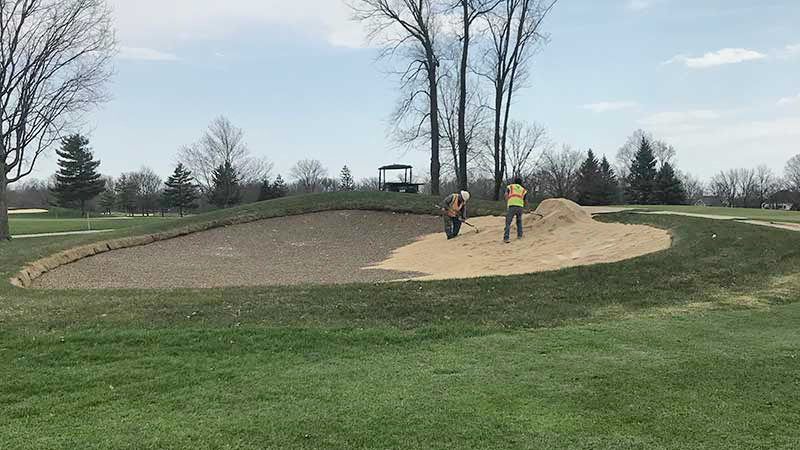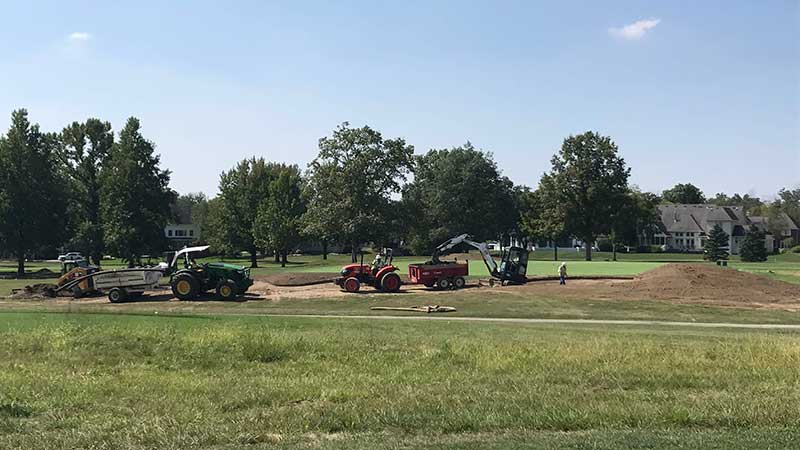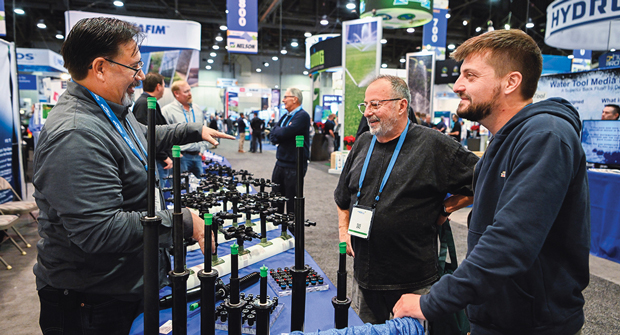How course modernized saucer-style bunkers

Chase Walden, superintendent of Old Oakland Golf Club in Indianapolis, Ind., says if you opt for an outside contractor to work on your bunkers, expect to work long hours as the crew wants to complete the job as quick as they can. (Photo: Chase Walden)
When it comes to renovating bunkers, superintendents have a big choice to make: go in-house or use an outside firm. Chase Walden, superintendent of Old Oakland Golf Club in Indianapolis, Ind., says this often is a question of manpower.
“If you have time to do it in-house and do a few bunkers at a time with your existing crew, I think it’s something you can do, especially if you’re not reshaping bunkers,” Walden says. “If you’re deciding to do a total renovation where you are removing bunkers and reshaping and moving a lot of dirt, I would highly recommend hiring a quality architect and shaper. A quality shaper that leaves a really good finished product doesn’t require a lot of hand labor to bring to finish is key.”
Walden said he learned a lot as he and his team oversaw a complete renovation of Old Oakland following the course’s purchase by local businessman Steve Sterrett.
“The bunkers needed attention, irrigation needed attention and we needed a new cart path — we did all that at the same time,” Walden says. “The bunkers were big giant saucers — a lot of them were out of play, they were pretty far away from the greens. We had really giant greens, and the new owner wanted to bring [the bunkers] more into play, closer to the greens and more strategic.”
Walden says the renovation was staggered in three phases on the 27-hole course. The first nine holes were renovated in the fall of 2016. The course worked with Ron Kern, an Indiana-based golf course architect.
“The architect and the shaper would paint out an area of disturbance, and we’d rototill that area and we incorporated that existing sand right back into the structure,” Walden says. “The shaper would come in and reshape the bunker based on the architect’s drawings.”
Old Oakland used Golf Creations and Duininck Golf to execute segments of the golf course renovations, and the course used Better Billy Bunker as the liner for all bunkers. In all, Walden says the course used six different contractors to execute portions of the project.

Also, expect some turf damage if your course is undergoing major renovation work from all the heavy equipment.
Some bunkers were removed, some were added, a short-game area renovated and irrigation was updated. The overall idea was to modernize the course. On top of adding new cart paths, the course also relocated some creeks.
“We had a lot of creek erosions and some holes that were just unfair to play,” he says. “We relocated a couple of creeks on the golf course, which was a major undertaking. We hired a local sixth contractor to come in and go through the permit process.”
Walden says it’s important to do your homework before beginning a project and to select a good contractor and architect. Expect to work longer hours if you opt to use a contractor, he says.
“If you make the decision to hire some contractors, the job will get done a lot quicker than in- house, but it’s an intense time when they’re here,” he says. “Those guys are coming from out of town, they’re staying in a hotel and will work till dark because they want to do the job quickly and get out of there.”
Also expect your role to change a little while you have outside contractors on your course.
“You become almost a general contractor,” he says. “Not only did we have a bunker renovation company on site, but we had an irrigation contractor and also a cart path contractor on-site at the same time. It was lot of moving parts.”
Another thing to anticipate is the volume of equipment and people on the course during construction.
“I remember starting out and roping off areas with stakes and caution tape trying to route construction traffic and spread out the wear,” he says. “Then I just realized we just need construction paths. You end up having to expect a lot of turf damage and just a lot of little things to repair once construction is over.”
However, he says, it got easier as each phase was completed, and “also, my family knew what to expect.” Walden says his two assistant superintendents were key in allowing him to manage contractors while they oversaw the holes that were open during renovation. He tips his hat at how his staff was able to “value engineer” parts of the renovation when contractor supplies would come in above budget.
“I knew it was going to be a short-term pain for long-term gain,” he says. “2020 is the first year we don’t have any major construction going on. We get to enjoy the fruits of our labor and go back to maintaining the golf course.”












